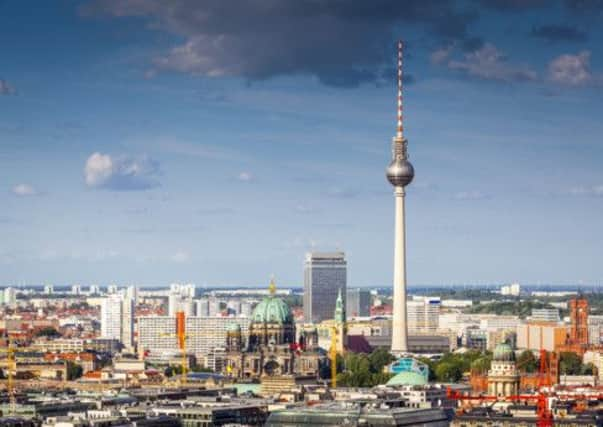Life’s rich cabaret


A chorus line of 32 stunning girls, high-kicking with military precision on a vast Berlin stage, prove to me that the city’s 1920s theatrical traditions are still alive and blooming.
I’m watching the multi-million pound revue Show Me, which opened last year at the enormous Friedrichstadt Palast in Berlin’s East End theatre district, during celebrations of the city’s 775th anniversary.
Advertisement
Hide AdAdvertisement
Hide AdIt is an amazing show, part Las Vegas and part Cirque du Soleil. Heavily influenced by America’s Ziegfeld Follies, it follows the tradition of German directors such as the great Max Reinhardt. He staged similar productions in Berlin during the Golden Twenties.
Now Twenties fever is experiencing a revival thanks to Baz Luhrmann’s decadent adaptation of The Great Gatsby. So it seemed fitting that I should revisit the real home of early 20th century razzmatazz, Berlin.
In the new liberal Weimar Republic created after the First World War, with stuffy Kaiser Wilhelm exiled to Holland, Berlin shed its inhibitions so wildly, that Swinging London 40 years later was a mere vicarage tea party by comparison.
Twenties Berlin was the crossroads of Europe, priding itself on its modernity. Censorship had been abolished and experimental theatre, music and film-making flourished.
Advertisement
Hide AdAdvertisement
Hide AdSince my youth I have been riveted by Berlin’s Second World War and postwar experiences, but above all, by its Weimar days, immortalised in Christopher Isherwood’s Berlin novels – Goodbye To Berlin and Mr Norris Changes Trains – from which the 1972 musical film Cabaret was created.
I first visited the city in 1966, when it was already divided by the Communist Wall, although tourist access to the Mitte (central) area behind the Wall was still possible. That part of Berlin was a near-wasteland of vacant sites where buildings had once stood. The Friedrichstrasse, the pre-war Oxford Street of Berlin, was a ghost of its former self.
The bombed Potsdamer Platz – an intersection as famous and busy as Piccadilly Circus before the war – was no longer functioning. It was in no-man’s land, near the barricaded, militarised Checkpoint Charlie, the main crossing into East Berlin through the Wall.
But now, standing at the Brandenburg Gate, looking down the Unter den Linden, I’m struck by how much rebuilding has taken place since 1966 and how the city is recovering.
Advertisement
Hide AdAdvertisement
Hide AdThe legendary Adlon Hotel – before the war, it was Berlin’s Ritz – is back in business as the Adlon-Kempinski. It was destroyed in 1945 and rebuilt only after the Wall came down in 1989.
Around the corner from the hotel is the Wilhelmstrasse – the Whitehall of pre-war Berlin. Hitler’s huge modernist Reich Chancellery, built by Albert Speer, used to be close by, but nothing of that remains today.
The notorious bunker where Hitler committed suicide has gone too. Years ago it was filled in, to avoid it becoming a shrine for neo-Nazis.
Short-stay visitors to Berlin will focus on the Mitte I base myself at the excellent budget hotel Motel One Berlin-Hauptbahnhof – named after the nearby main railway station.
Advertisement
Hide AdAdvertisement
Hide AdBravely, I opt for some unconventional methods of sightseeing. First, a tour in a bicycle Velotaxi. Pedalled by a fit young man, who acts as my guide, it’s like being conveyed by rickshaw in the Far East in colonial days. My next expedition is a Trabi Safari – a two-hour car trip along the route of the Wall in a convoy of probably the worst cars ever made. This is the Trabant, manufactured in East Germany in the Communist days and which emit clouds of toxic blue fumes as they chug along.
Berlin has not shied away from its 12 grim years under Hitler. There is a riveting photographic display in the basement of what used to be the Gestapo headquarters, at the Topographie des Terrors.
For me, the greatest symbol of Berlin’s renaissance is the rebirth of the Potsdamer Platz. It is back in business and the home of skyscrapers – which stand out in Berlin’s strikingly low-rise skyline. On Ebertstrasse, which runs up to the Brandenburg Gate, lies an important and significant memorial. It is modern Germany’s riposte to the anti-Semitic policies of the Third Reich, which led to the murder of millions of Jews.
The memorial takes the form of more than 2,700 unmarked blocks of grey stone, which visitors can wander through. It overlaps the site where the house of Joseph Goebbels once stood.
Advertisement
Hide AdAdvertisement
Hide AdIt’s important to recall that before Hitler rose to power, this buzzing city was one of the most exciting places in Europe.
Nightclubs may have taken the place of cabaret halls and cloche hats may have been replaced by an array of gravity-defying hairstyles, but that same spirit of carefree decadence is still very much alive.
Getting there
Anthony Looch was a guest of Motel One who offer eight budget design hotels in Berlin, with rooms from 49 euros (£41) and breakfast £7.50. Visit www.motel-one.com
Easyjet.com offer return flights to Berlin from £51 return. Visit www.easyjet.com